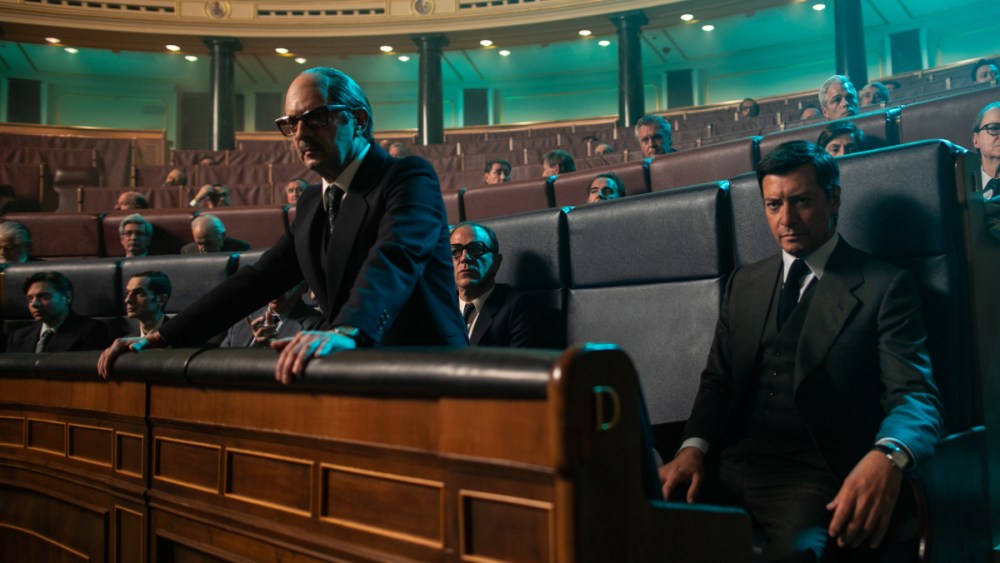Set in 1580 Seville, Spaniard Alberto Rodríguez’s 2017 series “The Plague,” a milestone in Spanish TV history, depicted how Spain took a wrong turn.
Inspired by Javier Cercas’ non-fiction book, starring Alvaro Morte (“Money Heist”) and acclaimed at September’s San Sebastián world premiere, Rodríguez’s “Anatomy of a Moment” tells how over 1976-81, Spain finally got it right, and how its hard-won young democracy also hung by a thread.
A “portrait of power and freedom, or at least how to maintain freedom for the future,” Rodríguez (“Prison 77”) tells Variety, the high-stakes thriller begins with the titular “moment”: a posse of some 200 Civil Guards breaking into Spain’s Congress, led by the pistol-brandishing Lieutenant Colonel Antonio Tejero, who spray the semi-circle with bullets. Most congressmen unceremoniously scramble to duck behind their benches. Three figures, however, – and the scene was caught on live on national TV – sit upright in their seats, refusing symbolically to bow before the coup’ d’état, convinced that they are going to die anyway: outgoing Spanish Prime Minister Adolfo Suárez, Santiago Carrillo, head of the Spanish Communist Party, and armed forces chief Manuel Gutiérrez Mellado who, though a frail near-70, got up to order the rebel Guards to lay down their arms.
The series then dedicates one episode a piece to all three: Ep. 1, how Suárez, Spanish Prime Minister from July 1976, persuaded Franco’s parliament to vote itself out of existence; how Santiago Carrillo, head of the Spanish Communist Party, returns to Spain and secures its legalization, and Gutiérrez Mellado’s battle to modernize of the army, removing its most radical elements. “These are figures,” says Rodríguez, of “Shakesperian stature.” The series portrays them in their grandeur, contradictions, traumas, chain-smoking and betrayal of the castes they came from.
This is the story of three traitors. Suárez went against his proclaimed fidelity to the Principles of the National Movement, Franco’s political system; Carrillo turned his back on the guiding principles of Spain’s Communist Party; Gutiérrez Mellado betrayed fellow Francoist officers with whom he had fought for Franco in the Spanish Civil War who were intent 40 years later on preserving a Francoist world order. A final episode returns to the coup d’état, why it failed, and the subsequent court martial of its leaders.
A fiction series, “The Anatomy of a Moment” is shot with flair, from its use of ellipsis – in Ep. 1, to portray Súarez’s dramatic rise in Francoist ranks, as a young Falangist Suárez guides a general into the office of the governor of Segovia: cut to its interior, where Suárez, now himself installed as governor, receives another general – and accompanied by a trenchant voice over, mostly written by scribes Rafael Cobos and Fran Araújo, explaining intricacies of characters and historical through-lines. “Your friend has only one political ideal, to thrive,” Alfonso Armada, head of the royal household, tells King Juan Carlos, when he names Suárez Prime Minister. “And he was entirely right,” the voice over runs.
Each episode channels a sense of genre: political comedy as Suárez buys Franco’s parliament, offering its members anything from a family cruise; espionage intrigue as Carrillo enters Spain incognito; court drama in the last, tinged with a note of melancholic elegy, as Súarez is forgotten and, suffering Alzheimer’s, forgets who he was himself.
Variety sat down with Rodríguez at San Sebastián where “The Anatomy of a Moment” celebrated its world premiere, acclaimed by El Mundo” as “magnetic” and by El Correo as “the series of the year.”
Your Goya best picture winning film “Marshland” is set in 1980 during Spain’s 1975-82 transition from dictatorship to democracy. Why return to the period?
Domingo Corral and Jose Manuel Lorenzo said: ‘Read Javier Cercas’ book, and then let’s talk.’ I did, and found it fascinating. First off, it re-orders reality, creating what could be regarded as a fantastic fiction. Them there’s the gutting ending, which is about oblivion, how everything disappears, including our referents. History ends up forgotten. In his prologue, Cercas quotes a poll carried out in the U.K. that a significant percentage of people thought Churchill didn’t exist, that he was a figure of fiction.
Also, the book, as your series, is structured around three figures when the essence of TV drama, its largest appeal to make viewers return to a second season, is its characters.
Yes, the three, Suárez, Carrillo and Gutiérrez-Mellado were extraordinary figures, with pronounced dramatic arcs, highly complex characters. Suárez was many things at the same time, Carrillo also. They were extremely personable, above everything around them. These are figures of a Shakespearian stature.
One of the key scenes in the series is when Suárez arranges a clandestine first meeting with Carrillo, when he’s returned to Spain. Against all odds, they immediately jell…
There’s a moment when Suárez says to Carrillo: ‘Don Santiago, you and I are the only real politicians in this country. Each sense the others’ weakness: Their egos. These are multi-faceted characters, with many layers, faces.
Another thing that stands out in the series is its voiceover, which can be highly ironic, or poetic and but also draw through lines from the present and future.…
Maybe 15% is drawn from Javier Cercas’ book. The rest comes from Rafa [Rafael Cobos] and Fran [Araújo]. It attempts to clarify the major guidelines of the story. The book is 500 pages long. We had to condense a lot.
You draw extraordinary performances from the actors, especially, perhaps, “Money Heist’s” Alvaro Morte, as Suárez. The first time Álvaro put on the prosthetic nose, it was as if he was another person. He studied a lot videos and other references. And Suárez was elegant. He would put on a suit and was elegant in any situation. Álvaro has that elegance too.
And if you had to say what the series is about?
It’s a portrait of power and freedom, or at least how to maintain freedom for the future.
